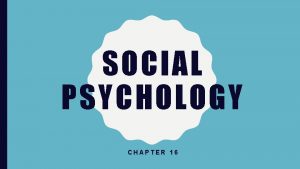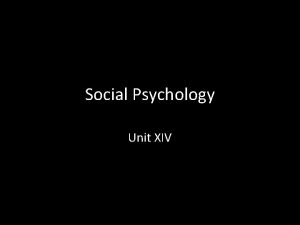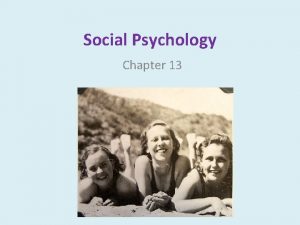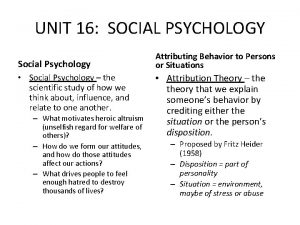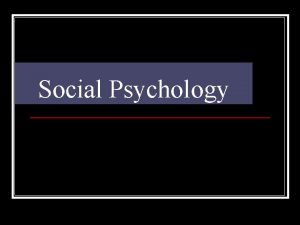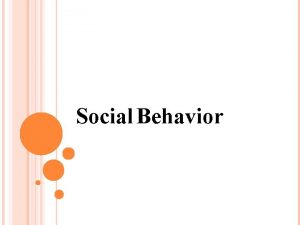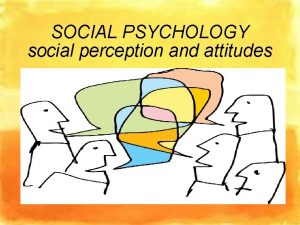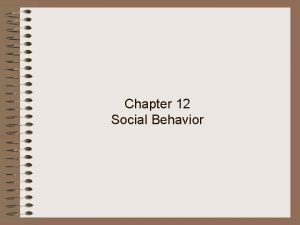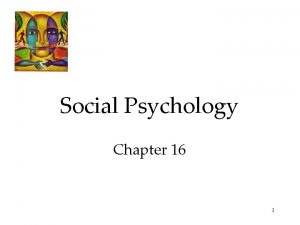Social Psychology What is Social Psychology The study




























- Slides: 28

Social Psychology

What is Social Psychology? • The study of how people influence and are influenced by other people. • How an individual is affected by the presence or implied presence of another individual or group • An individual’s thoughts, feelings, and behavior can all be influenced by the POWER OF THE SITUATION that they are experiencing.

Social Influence • Social psychology is a diverse field. We will focus on only one of the major areas of study. – Social influence • How we are influenced by others • Conformity, obedience, compliance

Social Influence • Social Influence: A few concepts – Social norms • Expectations / what is acceptable – Behavior, thoughts, affect – Social role • Sets of norms • Expectations for particular position • Unofficial Assignment: Violate a norm today (without getting expelled).

Conformity • Yield to real or imagined social pressure

Conformity • Changing one’s behavior or beliefs to match those of other group members, generally as a result of real or imagined, though unspoken, group pressure. – Sometimes conscious, sometimes not. • Is conformity good or bad? When?

Why do we conform? • Sherif (1930 s) AUTOKINETIC EFFECT – Was interested in the passing of norms from generation to generation. – Put people in a pitch black room that had a stationary pinpoint of light. – Would then ask participants how far the light moved. – Were questioned in groups of three multiple times. – Found that across sessions the answers began to align. – After a number of trials a new subject would replace one of the old subjects and would fall right into the group norm.

Why do we conform? • Private Conformity: involves both acting and believing in accord with social pressure. – Subjects still displayed these beliefs when placed in other groups or were shown the stimulus again and asked in private.

Why do we conform? Asch (1950 s) – Disagreed with the studies of Sherif • “Perceptual judgments” Only 1 real participant Others: confederates – – – • – Accomplices All responses scripted

Why do we conform? • • 18 trials, 50 participants = approximately 900 decisions to conform Conformity on 37% of trials 13 people never conformed, 74% conformed on at least one trial 14 people conformed on more than half their trials

Factors that affect extent of conformity • Group size – 1 < 2 < 3 < 4 = 5 = 6 = 7 = 8 = 9 = 10 = 11 = 12 … • Presence of a dissenter – If one other nonconformist , conformity rate drops from 37% to 5% Commitment • – Prior decision / initial judgment reduces later conformity Individual differences • – High self esteem = less likely to conform Friends versus strangers • – Asch method: Less conformity with friends

Why do we conform? • Public Conformity: publicly acting in accord with social pressure while privately disagreeing

Why do we conform? • Based on these two studies we can conclude two types of influences on conformity. – Informational Influence: conformity because you aren’t sure what to do (Private) – Normative Influence: Conforming to the group in order to gain acceptance (Public)

Obedience • Obedience: change in behavior based on a direct order from an authority figure – The figure can be legitimate (Arnal or Muhlhauser) or illegitimate (man holding a gun). • Stanley Milgram (1960 s)


Obedience • The Milgram Experiments – 18 studies between 1960 – 1963 • “The effects of punishment on learning” • Participants were the “teacher” • The “learner” was a confederate – All learner’s answers pre-scripted

Obedience • Teacher told to give increasingly intense shocks – 15 volt increments • • 15 -60 v 75 -120 v 135 -180 v 195 -240 v 255 -300 v 315 -360 v 375 -420 v 435 -450 v “slight” “moderate” “strong” “very strong” “intense” “extremely intense” “danger-severe shock” “XXX” • Each time the learner gave wrong answer the next switch was to be flipped. • NO ONE WAS ACTUALLY SHOCKED! – Except sample 45 volt shock

The Results • Predicted: • < 1% will obey to end – 450 volts • What really happened? • 65% obeyed to the end

Variations of original study: compare to 65% obeying to the very end -- 450 volts 1. No vocal feedback: Participants never heard screams / pounding – 93% 2. Proximity of victim: Learner in same room – 40% 3. Proximity of victim: Participant had to force the learner’s hand onto metal shock plate – 30%

Variations of original study: compare to 65% obeying to the very end -- 450 volts 4. Proximity of authority: Experimenter gave instructions by telephone – 20% 5. Personal responsibility: Participant read word pairs, another “teacher” (a confederate) pushed the button – 93% agreed to go to 450 volts 6. Gender: Women participants with original methodology – 65%

Ethical Implications • What do you think of this research?

“A hoax most cruel” April, 2004 • David R. Stewart was arrested in June 2004 • Charged with solicitation to commit sodomy, impersonating a police officer, soliciting sex abuse, unlawful imprisonment. • He pleaded not guilty • The trial lasted a week • Stewart was not convicted

Compliance • Compliance: adjusting one’s behavior because of an explicit request. – Key idea is that the requester has no real power or authority. – The goal as the requester is to get people to make a commitment.

Compliance • Foot – in – the – door technique (Freedman & Fraser, 1966) – 1 st: Ask for small favor • If agree… (99% do) – 2 nd: Ask large favor • 53% compliance • Compare: – Only large favor • 22% compliance • Self-perception change – “I guess I’m the type of person who…”

Compliance • Door – in – the – face technique (Cialdini and others, 1975) – 1 st: Make large, unreasonable request • 0% compliance – 2 nd: Make second, reasonable request • 50% compliance • Compare: – Only reasonable request • 17% compliance • Norm of reciprocity – Return favors

Compliance • Lowballing technique (Cialdini, 1978) – Make request and obtain compliance without admitting all costs • 56% compliance • Compare: – Request with all costs indicated “up front” • 31% compliance • Commitment – People follow through with decisions

Attitudes

Attitudes • Evaluation about some thing – Affective component • Emotions – Behavioral component • Predispositions to act – Cognitive component • Beliefs • Attitudes influence future behavior – However, sometimes behaviors do not match attitude. – Situational factors also impact behavior
 Social psychology definition psychology
Social psychology definition psychology Module 74 attribution attitudes and actions
Module 74 attribution attitudes and actions Group polarization simple definition
Group polarization simple definition Fundamental attribution error ap psychology
Fundamental attribution error ap psychology Hát kết hợp bộ gõ cơ thể
Hát kết hợp bộ gõ cơ thể Frameset trong html5
Frameset trong html5 Bổ thể
Bổ thể Tỉ lệ cơ thể trẻ em
Tỉ lệ cơ thể trẻ em Chó sói
Chó sói Tư thế worms-breton
Tư thế worms-breton Hát lên người ơi alleluia
Hát lên người ơi alleluia Môn thể thao bắt đầu bằng từ chạy
Môn thể thao bắt đầu bằng từ chạy Thế nào là hệ số cao nhất
Thế nào là hệ số cao nhất Các châu lục và đại dương trên thế giới
Các châu lục và đại dương trên thế giới Công của trọng lực
Công của trọng lực Trời xanh đây là của chúng ta thể thơ
Trời xanh đây là của chúng ta thể thơ Cách giải mật thư tọa độ
Cách giải mật thư tọa độ 101012 bằng
101012 bằng Phản ứng thế ankan
Phản ứng thế ankan Các châu lục và đại dương trên thế giới
Các châu lục và đại dương trên thế giới Thơ thất ngôn tứ tuyệt đường luật
Thơ thất ngôn tứ tuyệt đường luật Quá trình desamine hóa có thể tạo ra
Quá trình desamine hóa có thể tạo ra Một số thể thơ truyền thống
Một số thể thơ truyền thống Bàn tay mà dây bẩn
Bàn tay mà dây bẩn Vẽ hình chiếu vuông góc của vật thể sau
Vẽ hình chiếu vuông góc của vật thể sau Biện pháp chống mỏi cơ
Biện pháp chống mỏi cơ đặc điểm cơ thể của người tối cổ
đặc điểm cơ thể của người tối cổ Thế nào là giọng cùng tên?
Thế nào là giọng cùng tên? Vẽ hình chiếu đứng bằng cạnh của vật thể
Vẽ hình chiếu đứng bằng cạnh của vật thể






























